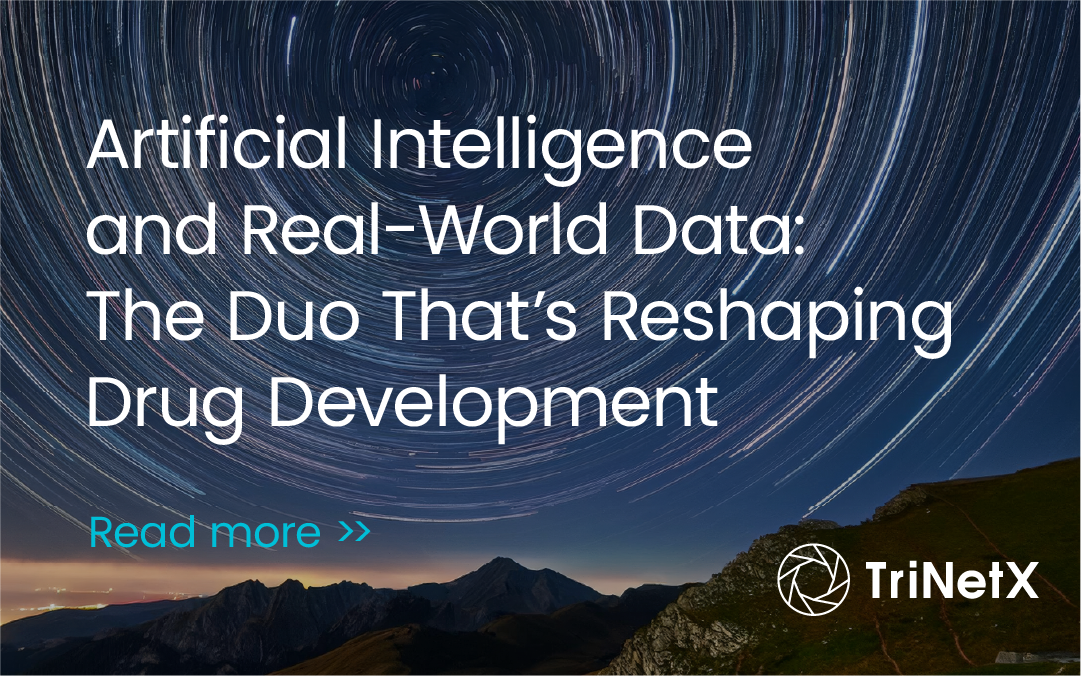In today’s era of exponential data growth, real-world data (RWD) is abundant, but its value hinges on our ability to interpret it with speed, scale, and precision. That’s where artificial intelligence (AI) comes into play. At TriNetX, we’re seeing firsthand how the integration of AI with RWD is transforming how biopharma approaches research, and why this pairing is emerging as one of the most powerful combinations in modern drug development.
In the 2025 TriNetX and studioID survey of 150 senior biopharma executives, an overwhelming 93% agreed that AI can make RWD more accessible and actionable. Over half of organizations have already begun using AI alongside RWD, with 17% reporting expansive use.
Why AI and RWD Make a Great Pair
The biopharma industry deals in exabytes of information. Manual processes, even with the best intentions, can’t keep up with the complexity and scale of today’s data demands. AI allows us to automate, accelerate, and deepen our understanding of data in ways that were previously unimaginable.
When AI and RWD come together, several things happen:
- Processes become smarter and faster. Clinical trials are complex. But with AI and RWD, we can automate data analysis, optimize timelines, and use resources more efficiently, ultimately saving both time and money.
- Decision-making gets sharper. Traditional analysis of RWD can yield important insights, but AI enhances that significantly. It uncovers layers of insight that allow researchers to explore hypotheses, identify trends, and find answers with greater confidence and speed.
- Predictive modeling becomes a reality. By leveraging AI on top of RWD, we can begin to predict outcomes and risks earlier in the development process. This helps teams pivot quickly, mitigating costly missteps before they occur.
- Regulatory pathways become more robust. AI-enhanced RWD can help validate that drugs work beyond the confines of a lab. It delivers the kind of real-world evidence (RWE) that regulators are increasingly looking for; evidence that’s grounded in real patient outcomes.
The recent explosion in generative AI has brought this technology into everyday life. What was once limited to research labs is now on our phones, in our homes, and embedded in our workflows. While the buzz can feel overwhelming, it’s not just hype. It reflects a genuine shift with major implications for our industry.
The Current Landscape: Promise Meets Caution
Despite high enthusiasm, only 17% of organizations in our survey say they’re using AI and RWD expansively. The biggest barrier cited by respondents? Data security. That caution is justified. As AI scales, even small weaknesses—whether in data privacy, quality, or bias—can be amplified with significant consequences. We’ve learned that responsible implementation starts with asking tough, foundational questions:
- Are data sources properly de-identified in accordance with applicable regulations, including the Health Insurance Portability and Accountability Act (HIPAA) and the General Data Protection Regulation (GDPR)?
- Do contracts and usage agreements explicitly restrict model training to research-only purposes?
- Are audit mechanisms in place to verify compliance?
These aren’t just checkboxes; they’re safeguards that ensure organizations can pursue AI-driven innovation without compromising ethics, security, or trust.
AI-RWD Use Cases Driving Measurable Value
For those leaning in, the results are already visible. At TriNetX, we’re seeing tangible value emerge across a range of applications. Four areas stand out:
- Optimizing Clinical Trial Diversity: Diversity in clinical trials is a scientific and ethical imperative. AI models can now evaluate how specific inclusion and exclusion criteria affect representation. By simulating adjustments before recruitment begins, we can design more inclusive trials without sacrificing scientific rigor.
- Early Cancer Detection: AI’s pattern recognition capabilities are enabling breakthroughs in early detection, especially in diseases that have traditionally been hard to screen for. In one case, AI was used to identify patients at risk of pancreatic cancer, a condition notorious for late diagnosis. Early intervention drastically improves outcomes, and AI makes this level of proactive care increasingly possible.
- Mapping Disease Progression: Understanding how diseases evolve over time is vital for developing targeted therapies. In follicular lymphoma, for instance, AI helped analyze lab values, treatment sequences, and clinical outcomes to map progression patterns. These insights allow biopharma teams to refine protocols and zero in on the most relevant patient populations.
- Generative AI for Protocol Development: Perhaps one of the most exciting advances is the use of generative AI to simplify protocol design. By enabling natural language queries against vast RWD sets, researchers can “chat with the data” to explore feasibility questions in real time. That kind of accessibility opens the door to faster, more informed study design.
Together, these capabilities make trials not only faster and more adaptive, but also more patient centric. They’re particularly impactful in decentralized or adaptive trial models, where flexibility is key.
The Cultural and Organizational Shift
Unlocking the AI-RWD transformation relies on more than technology; culture plays a critical role as well. To successfully integrate AI, biopharma organizations need cross-functional collaboration across data science, clinical operations, and compliance teams. They need training that ensures staff can interpret AI outputs in clinical and regulatory contexts. And they need governance frameworks to ensure transparency and reproducibility.
AI isn’t about replacing the scientific process; it’s about augmenting it. When used correctly, it empowers faster, better-informed decisions rooted in broader, more diverse evidence.
This is what excites me most: AI is helping researchers accelerate and optimize clinical trials. It’s helping regulators assess safety and efficacy with richer context. And ultimately, it’s helping patients get access to therapies that are more tailored, timely, and effective.
About Steve Kundrot
Steve is a technology and business leader with over 20 years of experience in clinical research, health analytics, consulting, and software development. As Chief Operating Officer, he oversees TriNetX’s core operational functions and leads the development of a unified product roadmap designed to revolutionize clinical research and accelerate drug development by optimizing clinical trial design, enhancing post-market safety, and delivering research-grade data and evidence that enable and expedite regulatory approvals.

